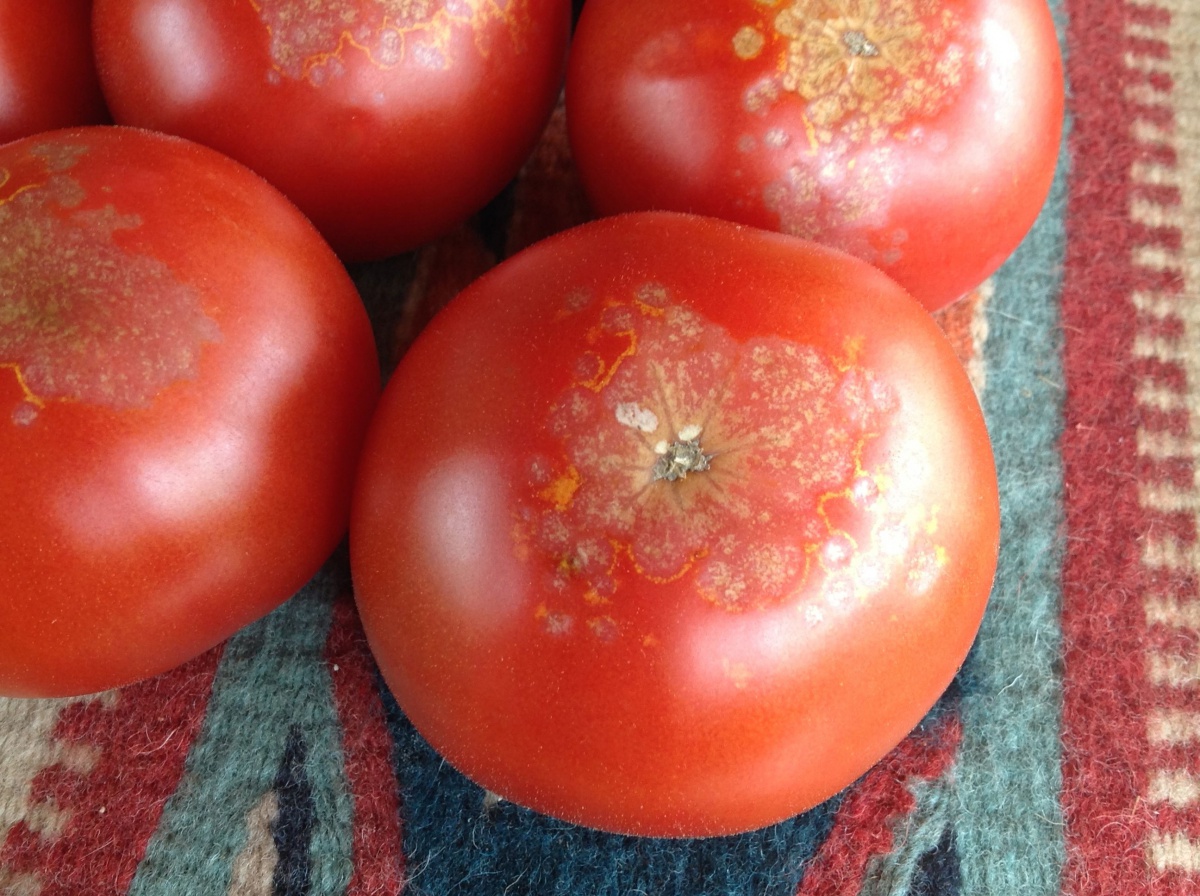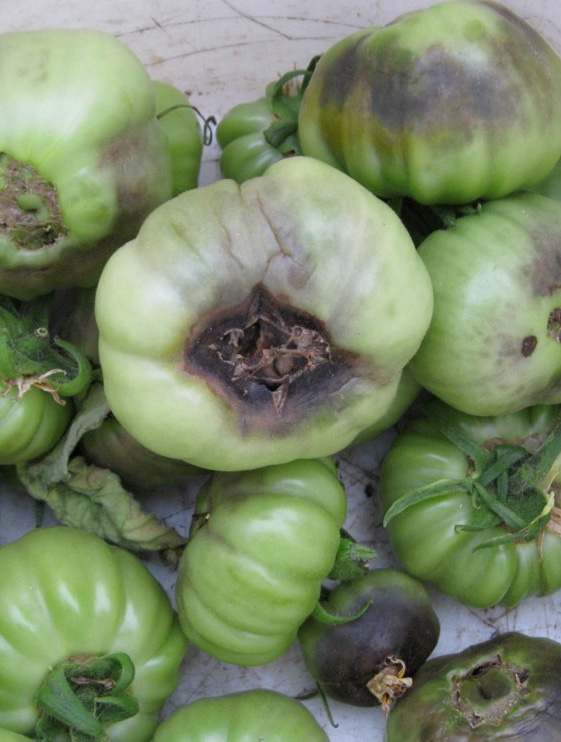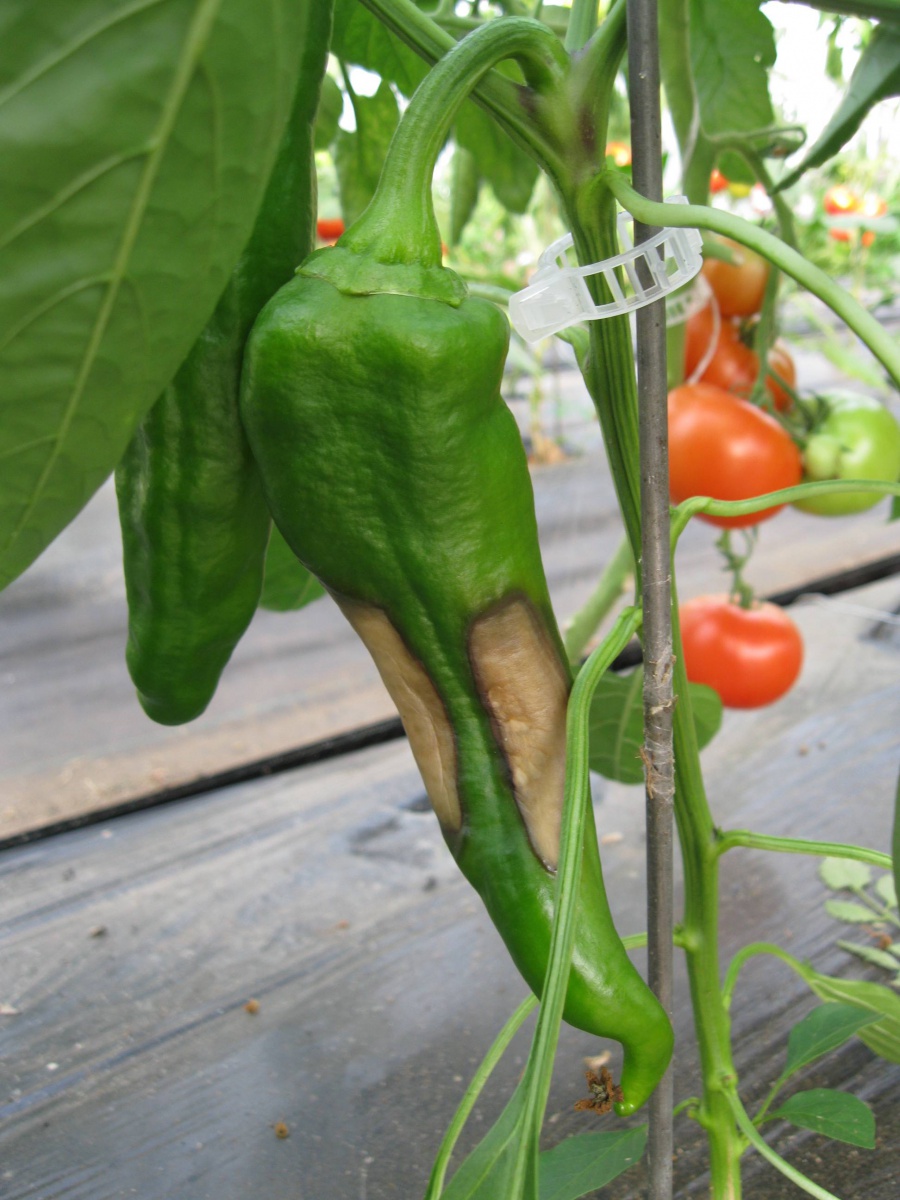Blossom-end rot (BER) is a disorder that commonly affects tomato, pepper and squash. Symptoms are caused by the death of a group of cells in the young expanding fruit. Initially, symptoms appear as a water-soaked area that becomes a dark brown or black dry rot. Secondary infections, such as botrytis (gray mold), may also occur. In mild cases, the lesions may be restricted to just a couple of layers of cells on the surface of the fruit.
Symptoms are most commonly observed at the blossom-end of the fruit but occasionally, placental tissue is damaged and symptoms may occur on the sides of the fruit rather than at the blossom-end. In pepper, lesions are frequently on the side of the fruit and look identical to sunscald. When fruits that are well-protected by foliage show extensive sunscald symptoms, this indicates that BER may be involved instead.

What causes it?
Since the 1940s, scientists have known that BER is most severe in tomato fruits that have low calcium concentrations. This has been confirmed by many studies, and BER is generally considered to be caused by a localized calcium deficiency. Some researchers (Saure, 2014) now believe that the calcium deficiency may be caused by BER, and not the other way around. One reason for this thinking is that fruits with very low levels of calcium do not necessarily develop BER. Also, in studies where fruits were followed through development, fruits that were just about to develop BER symptoms had the same levels and distribution of calcium as those fruits that did not develop BER.
Stresses, including high salinity, drought, high temperature, and high light intensity, are believed to play a pivotal role in causing BER. On their own, these stresses trigger the production of reactive oxygen species that damage cell membranes. This damage causes loss of ions (including calcium), particularly in sensitive areas (the tips and placental tissue of developing fruit). This can, but does not always, result in metabolic problems and cell death at the rapidly growing tips of developing fruits (BER).
Saure (2014) argues that a period of lush vegetative growth makes plants more susceptible to BER, and that severe stresses cause BER in these sensitive plants.
Why does lush growth make plants more susceptible to BER? While researchers still do not have all the answers, some new research has shed more light on the issue. Highly vegetative growth causes plants to produce higher levels of giberellic acids (GA), which are naturally produced plant hormones, in developing fruits. This, in turn, restricts calcium concentrations in the end of the fruit, so that cell membranes can become permeable so the young fruits can expand rapidly. When stresses further affect cell membranes and reduce fruit calcium levels, this makes the risk of triggering cell death (and BER) much more likely. Consistent with this idea, researchers have shown that applying GA to stressed plants dramatically increases BER (De Freitas et al. 2012).
Another naturally occurring plant hormone, abscisic acid (ABA), is antagonistic to (acts in the opposite direction as) GA, and both of these are involved in several aspects of plant development. ABA is known to enhance stress resistance of plants. Specifically, ABA reduces transpiration, or loss of water from plant leaves, often improving plant water status. A recent study by researchers in Brazil and at the University of California, Davis showed that applying ABA to highly stressed tomato plants alleviated BER symptoms (De Freitas et al. 2014). Spraying ABA onto plants is not a commercial solution, however, for two reasons: 1) plant hormones have a wide range of effects that may not be predictable or desirable, and 2) there are no commercial formulations of ABA that are labeled for use on food crops.

What are the solutions?
Many factors are involved in BER, which makes it difficult to identify the exact cause(s) in a particular setting – which complicates management. Further, many of these factors are affected by the weather, which is variable, unpredictable, and beyond our control. Still, there are several practices that can help reduce the risks of BER. The goal of all of these is to avoid growth spurts and minimize plant stresses, thereby maximizing the accumulation of calcium in young developing fruits.
Irrigation. The most common recommendation to prevent BER is to focus on water management to try to minimize drought stress or waterlogging. Doing this is easier for those growing in climate-controlled greenhouses and in well-drained media and computerized systems, and becomes progressively more difficult for those growing in-ground (especially if drainage and soil texture varies throughout the area), those growing outdoors where rainfall is a factor, and those that are hand-watering. Water requirements vary with the weather, so completely automated systems may not prevent water stress to plants. Those growing in-ground may find tensiometers a useful tool in helping to monitor soil water status in the root zone.
Soil testing. Low soil calcium levels make BER more likely, but low soil calcium is very rare in managed soils in New England. However, having very high concentrations of nutrients that compete with calcium for uptake (e.g. ammonium and potassium) can also exacerbate BER. Soil testing can also help avoid salinity stress, which increases the risk of BER. If crops have been grown for several years in a covered high tunnel, make sure to test for soluble salts as well as other macronutrients on a regular basis. Because our climate receives abundant rainfall, salts can be leached naturally when you change the plastic, by allowing the tunnel soil to experience fall and winter rain. For those that are fertigating with nutrient solutions, don’t overdo it. Several studies have shown that higher electrical conductivity (EC) nutrient solutions increase chance of BER compared with lower EC solutions.
Shadecloth. High heat and light intensity can be very common in the summer in New England. Ensuring that there is sufficient leaf cover to protect fruit from direct sunlight can minimize several disorders, including yellow shoulders and uneven ripening. The use of shadecloth has been reported to reduce BER in tomato in some, but not all, studies. Martin Gent at the Connecticut Agricultural Experiment Station did many experiments to evaluate the effects of shadecloth on greenhouse tomato quality. In his studies, applying shadecloth during the heat of summer didn’t affect the low levels of BER he observed, but that it consistently helped increase the percentage of marketable fruits, particularly by reducing cracking, and in some cases reduced uneven ripening (Gent 2007).
Calcium fruit sprays. Some researchers have reported that the application of calcium sprays directly to developing fruit can reduce the incidence of BER (Ho and White, 2005), but many others have reported that they did not reduce BER and were labor-intensive to apply, and in some cases reduced marketable yields. To be effective, they need to be applied directly to the young fruits (not to foliage) before the development of BER symptoms and would need to be applied continuously throughout fruit development. Several commercial calcium products exist for this purpose, and on-farm experimentation may be worthwhile. At this point, we don’t have enough evidence to recommend their use in managing BER.
Keep plant growth under check. Conditions that lead to growth spurts and rapid expansion of young fruits enhance the risks of BER. These conditions include: 1) maintaining a very high leaf:- fruit ratio with excessive vegetative growth as compared with fruit yield (researchers have shown that thinning fruit clusters increases fruit size, but increases the chances of BER), and 2) having high light intensities and temperatures in the canopy. Therefore, encouraging good fruit set, limiting excessive vegetative growth, and trying to keep temperatures and light intensity down (possibly using shadecloth) can help avoid these problems.
Limit transpiration? A dry, low-humidity environment makes plants transpire more, or lose more moisture through their leaves, and makes plants take up more moisture through their roots. While it seems that it would bring more calcium to growing fruits, it actually draws calcium away from developing fruits and increases the likelihood of BER; many studies have shown that increasing humidity reduces BER (Bertin et al. 2000). If BER were our only concern, we’d want to maintain very high humidity. But there are drawbacks. Because high humidity can increase the chances of cracking (Peet 1992), and it is also favors plant diseases such as tomato leaf mold (Fulvia fulvum), we recommend maintaining moderate humidity with good air flow.
Remove affected fruits. Particularly for squash, but also for tomato, BER occurs most commonly at the very beginning of the harvest season. For summer squash and zucchini, the first couple of fruits are often affected, but rarely does BER continue throughout the production season. Remove affected fruits, since they will not recover, and wait for the next fruits to be produced.
Variety selection. Some varieties are more susceptible to BER than others. Because of the number of factors involved in the development of this disorder, a definitive list of resistant and susceptible varieties are not available. However, plum and pear-shaped tomatoes are more susceptible than round-fruited varieties, and BER has not been reported for cherry tomatoes.

Sources
Bertin et al. 2000. Seasonal evolution of the quality of fresh glasshouse tomatoes under Meditteranean conditions, as affected by air vapour pressure deficit and plant fruit load. Annals of Botany 85:741-750.
De Freitas, ST et al. 2014. Calcium partitioning and allocation and blossom-end rot development in tomato plants in response to whole- plant and fruit-specific abscisic acid treatments. J. Experimental Botany 65(1): 235-247.
Gent, MA. 2007. Effect of degree and duration of shade on quality of greenhouse tomato. HortScience 42(3): 514-520.
Ho, LC and PJ White. 2005. A cellular hypothesis for the induction of blossom-end rot in tomato fruit. Annals of Botany 95: 571-581. Peet, MM 1992. Fruit cracking in tomato. HortTechnology 2(2):216- 223.
Saure, M. 2014. Why calcium deficiency is not the cause of blossom-end rot in tomato and pepper fruit – a reappraisal. Scientia Horticulturae 174:151-154.
Download the Resource for the complete fact sheet and a printable version.
